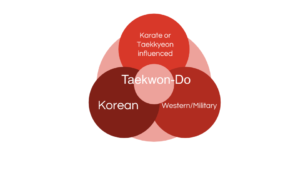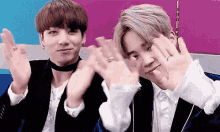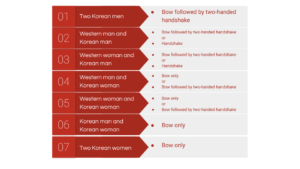
Why is it that in Taekwon-Do we shake with two hands instead of one? Should the left hand be palm up or palm down?
Over the years I have heard various (sometimes hilarious) interpretations and misinterpretations of the handshake used in Taekwon-Do. I have come across Taekwon-Do-ins saying that the supporting left hand is to help keep your right arm up, or to show that you are not concealing a weapon in the sleeve, and my personal favourite: to stop your sleeve from being dunked into a bowl of soup.
There is a lot of overlap between Korean customs, Western customs, military protocols, influences from Karate/Taekkyeon and Taekwon-Do etiquette, sometimes it’s difficult to know which of these three sects a certain mannerism comes from. But I can assure you that the two-handed handshake has absolutely nothing to do with the sleeve or soup for that matter.
This article is going to assume that the two-handed handshake stems from Korean etiquette.
Before we start, there are two things that you must understand:
- In Korean culture and customs, there is a huge emphasis on social hierarchy.
- Modern-day Korea adopts a blend of traditional Korean customs and Western customs.
The two-handed handshake is a way to show politeness and respect to your elders and superiors. In Korean culture, it is considered extremely rude to give or receive items using just one hand to someone who is older than you or who is your superior. The idea is that using one hand can be considered lazy and careless, whereas using two hands shows effort, submission, and humility.
The two-handed etiquette applies when you are offering something to or receiving something from your elders, including when pouring drinks. In fact, you will even sometimes see Koreans wave with two hands.

Traditionally, Koreans did not used to greet each other with a handshake. The traditional Korean greeting has always been a bow. In the present day, the formal Korean greeting invariably starts with a bow, and then it may be accompanied by a handshake.

There is never hugging or kisses to the cheek, so you should avoid making any of these mistakes with a Korean person.
At first glance, it may seem that there is gender bias, but it is purely a product of Korean businessmen adopting customs of the West. Most Korean women do not feel comfortable with touching or shaking hands with a male stranger, whether he is Korean or not.
The correct method and protocol with the two-handed handshake:
The left hand is to support the right hand (anywhere between the right elbow and right wrist), so to answer the question, “Should the palm be up or down?”, the palm is typically up or facing the right-side.
In saying this, there are several different ways of performing the two-handed handshake in Korea, the best demonstration of the variety I have seen is this video of K-pop artists BTS meeting Janet Jackson for the first time.
You will see the first male Tae-hyung Kim (Stage name: V), he comes in with his left arm touching his own body. I like to call this the “I have a tummy ache” handshake. This is considered polite, but less formal because it is not technically ‘two-handed’. He has his left hand on his stomach, which is part of the motion of a deep bow. The deep bow is very respectful, but the two-hand rule is always more formal, polite and respectful when it comes to handshakes.
The second handshake from Nam-Joon Kim (Stage name: RM) is the traditional two-handed handshake. The left arm is cupping/holding the right forearm.
The third handshake by Jimin Park (in red jacket), is also a two-handed handshake. But as you can see from the video, his left-hand touches the right hand of the other person. This is considered an affectionate handshake. This intimate style of a handshake is usually reserved for good friends, family members or family friends.
The following three handshakes from Jin, Jungkook, J-Hope are the same style as RM.
The final handshake by Suga is the typical Western one-handed handshake.
The two-handed handshake is a blend of Western and Korean customs. The origins of the Western handshake as a greeting dates back to the 5th Century. It was a symbol of peace, indicating that neither party was holding or concealing a weapon. It is also used as a means of bidding farewell, congratulating, coming to an agreement with, or thanking someone.
This custom is likely to have crossed over to Korea in the late 18th or early 19th century due to international business relations, military alliances, and friendships.
Which of these is more suitable for Taekwon-Do?
For Taekwon-Do, the handshakes performed by RM, Jin, Jungkook, and J-Hope are more suitable, more polite, more formal method of the two-handed handshake. It is the ‘safest’ bet.
Note that none of them have their left palm facing down (like a bad version of the straight fingertip thrust)!
Irene Yu, 2nd Dan
